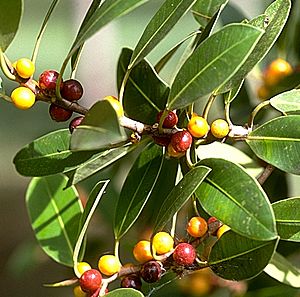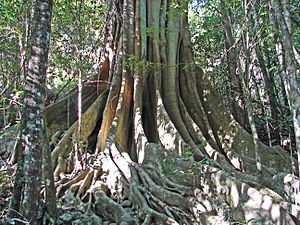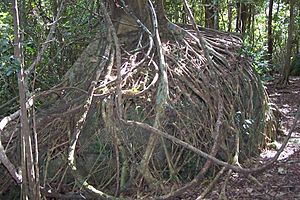Small-leaved fig facts for kids
Quick facts for kids Small-leaved fig |
|
|---|---|
 |
|
| Ficus obliqua, Milton, New South Wales | |
 |
|
| Conservation status | |
| Scientific classification | |
| Genus: |
Ficus
|
| Species: |
obliqua
|
| Synonyms | |
|
Ficus obliqua G.Forst. var. obliqua |
|
The small-leaved fig, known scientifically as Ficus obliqua, is a type of tree from the Moraceae family. This family also includes the well-known edible fig (Ficus carica). You can find this tree growing naturally in eastern Australia, New Guinea, eastern Indonesia, and islands in the southwestern Pacific Ocean.
This fig tree is a kind of banyan tree. It often starts its life as a tiny seedling growing on other plants (called an epiphyte) or on rocks (called a lithophyte). Over time, it can grow very tall, up to 60 m (200 ft) high, and spread out almost as wide. It has a pale grey trunk with large buttressed roots that help support it. Its leaves are glossy and green. The small, round, yellow fruits ripen and turn red throughout the year, but especially from April to July. These fruits are special because their flowers grow inside them! Small-leaved figs are pollinated by tiny fig wasps. Many birds and even flying foxes love to eat the fruit. This tree grows in different habitats like rainforests and savanna woodlands. People often plant it in parks for shade, and it can also be grown as an indoor plant or shaped into bonsai. In Fiji, parts of the tree have been used in traditional medicine.
Contents
What's in a Name?
The small-leaved fig was first described in 1786 by a German scientist named Georg Forster. He found the tree in Vanuatu. For many years, it was known by a different name, Ficus eugenioides. However, because Forster's name was given first, it is the official name today. The word obliqua in its scientific name is Latin for "oblique," but it's not clear what part of the tree this refers to.
Scientists group plants into categories. The Ficus genus, which includes all fig trees, is very large, with over 750 different species. Ficus obliqua is part of this big family.
Tree Features

The small-leaved fig tree can grow to be very tall, from 15–60 m (49–197 ft) high, with a wide crown (the leafy top part). It has smooth, thin, grey bark. The trunk can become very wide, up to 3 m (9.8 ft) across, with strong buttressed roots.
Its glossy green leaves are usually 5–8 cm (2.0–3.1 in) long and 2–3.5 cm (0.79–1.38 in) wide. They grow one after another along the stems. The small, round, yellow fruits grow in pairs and turn orange or red when they are ripe. They are about 6 to 10 mm (0.24 to 0.39 in) wide. You can find fruit on the tree at any time of year, but especially from April to July. Like all figs, the fruit is actually an upside-down flower cluster called a syconium, with tiny flowers inside. Each fig tree has both male and female flowers in the same fruit. The female flowers mature before the male ones.
Sometimes, people confuse the small-leaved fig with another fig tree called the rusty fig (F. rubiginosa). You can tell the small-leaved fig apart because its fruits are smaller and its leaves are smooth and hairless.
Where It Grows
Ficus obliqua grows along the east coast of Australia, from southern New South Wales all the way north to the tip of Cape York Peninsula in Queensland. It also grows in New Guinea, parts of Indonesia, and islands in the southwestern Pacific like New Caledonia, Fiji, Tonga, Samoa, and Vanuatu. It prefers soils that have a lot of nutrients and water. You can find it in warm rainforests and moist subtropical areas. Very large small-leaved fig trees can even grow taller than the main canopy of the rainforest.
Animals and the Fig Tree
Many animals rely on the small-leaved fig for food. Several types of birds, including the double-eyed fig parrot, rainbow lorikeet, and various pigeons and doves, eat its fruit. When they eat the fruit, they help spread the seeds to new places. Flying foxes, like the spectacled flying fox and grey-headed flying fox, also enjoy the fruit.
The leaves of the small-leaved fig are a food source for the caterpillars of certain butterfly and Geometer moth species. Tiny insects called thrips also feed on the new leaves. When thrips feed, they can cause the leaves to curl up and form small bumps called galls, which protect them.
Reproduction and Life Cycle
Fig trees and fig wasps have a very special relationship called mutualism. This means they both need each other to survive. Fig trees can only be pollinated by fig wasps, and fig wasps can only lay their eggs and reproduce inside fig flowers. Each fig species usually has its own specific fig wasp species that pollinates it. For Ficus obliqua, two types of fig wasps do the job: Pleistodontes greenwoodi and P. xanthocephalus.
Inside each fig fruit, the female and male flowers mature at different times. Female wasps enter the fruit and lay their eggs in the female flowers. When the new wasps hatch, they mate. The female wasps then collect pollen from the male flowers, which are now ready, and fly off to other fig fruits to start the process again. This helps the fig tree make seeds.
The animals that eat the figs help spread the seeds. When the seeds land on other plants or rocks, they start to grow. As the new fig plant gets bigger, it sends roots down to the ground. If it's growing on another plant, its roots can eventually wrap around and "strangle" the host plant. Small-leaved fig trees can live for a very long time, sometimes more than 500 years!
How People Use It

The small-leaved fig is a beautiful shade tree that's great for parks or large open spaces. It can grow in different types of soil. A famous small-leaved fig tree in Milton, New South Wales, is 14 m (46 ft) tall and 38 m (125 ft) wide, and it's a well-known local landmark. However, because its roots can spread out a lot and invade pipes or garden beds, it's not the best choice for small home gardens. Also, fig trees drop a lot of fruit and leaves, which can make a mess.
Even though it's not as common as some other fig species for bonsai, the small-leaved fig is actually very good for it. Its small leaves and the way its trunk can thicken make it perfect for creating miniature trees between 10–80 cm (3.9–31.5 in) tall. It's especially popular in bonsai nurseries around Brisbane, Australia. It can also be grown as an indoor plant in places with different light levels. The wood of this tree is too soft to be used for building or furniture.
In Fiji, the small-leaved fig is called baka or baka ni viti. People there have traditionally used different parts of the tree in medicine. For example, its white sap has been used for swollen joints or boils. It was also considered a sacred tree in Fiji.
See also
 In Spanish: Higuera de hojas chicas para niños
In Spanish: Higuera de hojas chicas para niños




